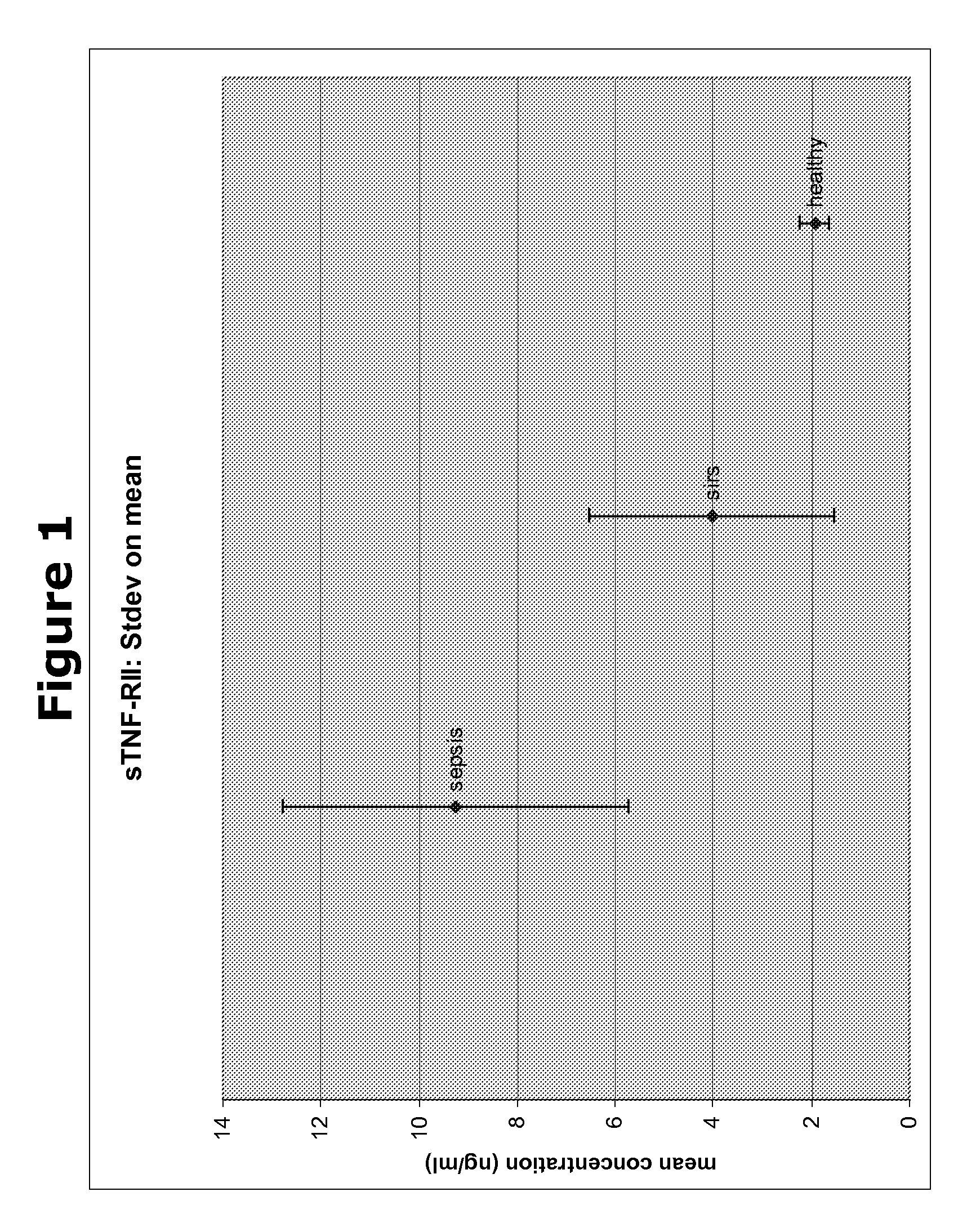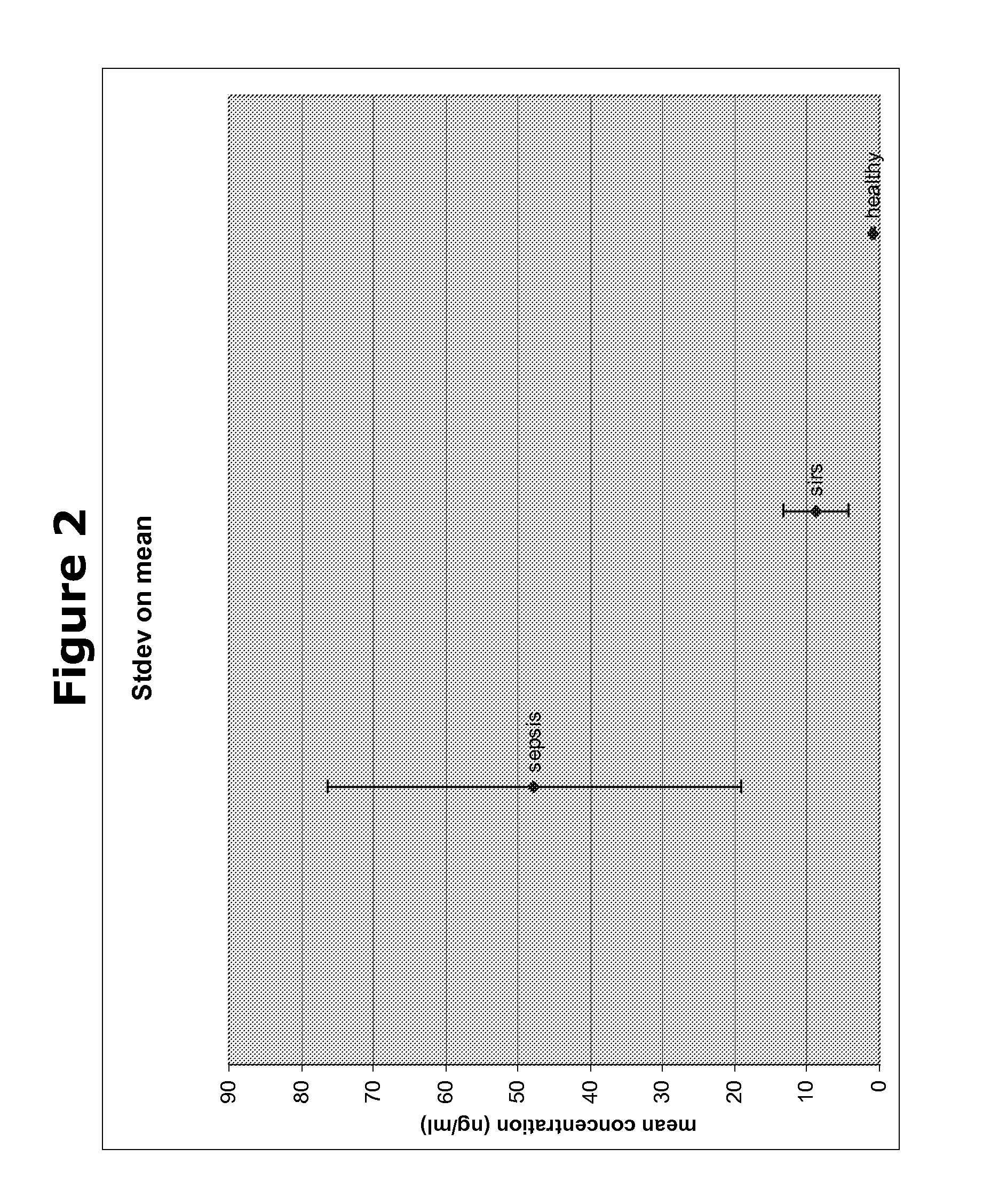Biomarkers and methods for diagnosing, predicting and/or prognosing sepsis and uses thereof
a biomarker and sepsis technology, applied in the field of protein and/or peptide based, can solve the problems of inability to effectively detect early sepsis, many drugs that may be beneficial for some patients may not work well, not at all, and adverse effects in other patients, so as to achieve accurate, rapid, and sensitive prediction, prognosis and/or diagnosis
- Summary
- Abstract
- Description
- Claims
- Application Information
AI Technical Summary
Benefits of technology
Problems solved by technology
Method used
Image
Examples
example 1
Identification of New Biomarkers for Sepsis
[0172]In order to find new biomarkers to diagnosis sepsis or SIRS, we determined the protein profile of blood samples obtained from healthy human subjects and samples from subjects having sepsis or SIRS without sepsis. The analysis was done using mass spectrometric detection of protein levels using our previously published COFRADIC™ technology platform.
[0173]In a reference design study each sample is measured against a reference sample, typically a pool of all patient samples. For each feature present in a certain sample a ratio is obtained which represents the fold difference of the feature intensity in the reference versus feature intensity in the sample. Combining all feature data from all samples into an expression matrix allows comparing features intensities between samples and between groups of samples.
[0174]For the SIRS / SEPSIS a 10-10 reference design study was set up and hence the reference pool was a pool of all 20 samples. An inte...
example 2
ELISA Measurements of the Newly Identified Biomarkers of the Invention in Samples from Patients Suffering from SIRS or Several Stages of Sepsis
[0184]In a next experiment, the biomarkers obtained from the Cofradic analysis were analysed for their differential expression in blood samples from patients suffering from SIRS or several stages of sepsis, using ELISA with specific antibodies directed to each of the biomarkers. As can be seen in Table 2 of the present application, we compared the quantity of these five protein biomarkers in the different blood samples with two known SIRS / sepsis biomarkers procalcitonin (PCT) and c-reactive protein (CRP). From the table it becomes clear that markers X1-X5 show a clear difference in protein quantity between samples from healthy subjects and the samples form subjects suffering from SIRS or sepsis. The results are shown in FIGS. 1-5 for X1-X5 respectively.
[0185]For the detection of human Pentraxin-3, we used a monoclonal mouse anti-human Pentrax...
example 3
Testing the Predictive Characteristics of Different Combinations of the Identified Biomarkers
[0191]In order to test the predictive power of the identified markers, we employed a classification framework as opposed to a summarizing statstical approach. A classifier is induced from the data that implements a model that can then be used to predict the class (sepsis / sirs) of a new patient. The generalization error (an estimate of how the classifier will perform on new patients) is computed using Leave-One-Out error. The data set of the ELISA measurements is given in Table 3. Note that we included ELISA measurements of both PCT and CRP, two known and widely used biomarkers for sepsis.
TABLE 3Data set of the ELISA measurements (conc. In ng / ml)MarkersTNFR2PTX-3M-CSFPro-HEPCpro-BNPPatientClassPCTCRPX4X2X5X3X1HGE67SEPSIS128.536912.2554.0155.9152.629.84UGE22SEPSIS226.12249.5972.0852.727138.1918.21HGE74SEPSIS5.23356.8217.9372.02273.93.86UGE41SEPSIS4.53477.8915.9453.62105.785.71UGE10SEPSIS27.371...
PUM
| Property | Measurement | Unit |
|---|---|---|
| temperature | aaaaa | aaaaa |
| blood pressure | aaaaa | aaaaa |
| blood pressure | aaaaa | aaaaa |
Abstract
Description
Claims
Application Information
 Login to View More
Login to View More - R&D
- Intellectual Property
- Life Sciences
- Materials
- Tech Scout
- Unparalleled Data Quality
- Higher Quality Content
- 60% Fewer Hallucinations
Browse by: Latest US Patents, China's latest patents, Technical Efficacy Thesaurus, Application Domain, Technology Topic, Popular Technical Reports.
© 2025 PatSnap. All rights reserved.Legal|Privacy policy|Modern Slavery Act Transparency Statement|Sitemap|About US| Contact US: help@patsnap.com



